► CAR guides you through the best city cars of 2024
► Electric and convertible options make the cut
► Cheap, reliable and viable small car choices
If you are browsing the best new car lists for something that will be used primarily for nipping around town in, picking one of the top new city cars would be a great move. They’re compact, making them a doddle to manoeuvre and park, and their low running costs means that they won’t eat away at your annual budget.
More to the point, long gone are the days when city cars were typically cramped, ugly, and excruciatingly uncool little cars; modern city cars are often vibrant, charismatic, enjoyable to drive, practical and well equipped – and offer a motoring experience closer now to that of the best new superminis, albeit one wrapped up in a smaller and neater package.
The best new city cars 2024 at a glance
These cars, which are ideal for avoiding public transport in cities, and ideal for getting out of cities as well, are however sadly becoming less common. Changes in regulations has made new city cars a tough proposition for manufacturers on the profit front, causing many to pull even the most popular models from their ranges.
You’re not flat out of luck, though: although the array of best small city cars on offer has shrunk in recent years, there are still several great options out there. We’ve extracted the data from CAR magazine’s long-standing GBU – the Good, the Bad and the Ugly – data section, and trawled our most recent tests, to come up with a straightforward list of the best new city cars around, helping you effortlessly pick out a car that’ll suit your runaround or compact family car requirements.
Best city cars in 2024
Hyundai i10
A stylish and sophisticated city car
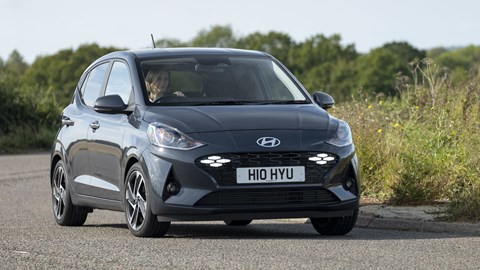
Pros: Lots of interior space; good equipment and options; pleasant to drive
Cons: Automatic option is terrible; not as cheap as some alternatives
The Hyundai i10 is a great choice if you’re looking for a practical city car that’s easy to live with and well equipped. It offers more room in the back seats than many superminis, and also benefits from a new infotainment system complete with grown-up features like wireless phone charging, connected sat nav with real-time updates, and a companion phone app that can remotely lock the car.
It’s a neat little car to drive, too, although you might find the standard 66bhp 1.0-litre engine a bit weedy on open roads. If you intend to venture out of the city a lot, go for the more powerful 1.2-litre petrol. Just avoid the automatic versions, as they use a terrible automated manual transmission. Alternatively, if you’ve the budget, go for the sporty N Line model, which is a fun little machine that packs a more flexible 1.0-litre turbocharged petrol engine. In any case, all benefit from a strong ownership package, including a five-year warranty, further making the i10 an appealing prospect.
For a more in-depth look read our Hyundai i10 review
Suzuki Ignis
Funky Ignis offers all-wheel drive
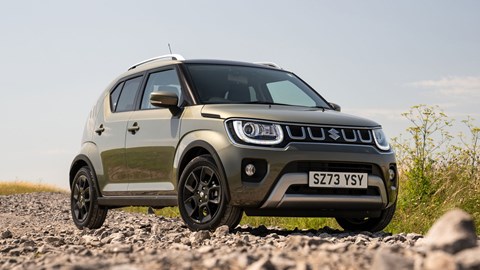
Pros: Minimal-fuss ownership; enjoyable to drive; characterful and useful
Cons: Not great on motorways; feels cheap in places; dated infotainment
If you want a straightforward city car that’s easy to live with but not a complete snoozefest, Suzuki’s dinky Ignis is worth a gander. The distinctive runabout doesn’t feel quite as upmarket as some as the alternatives here, but it’s sweet to drive, interestingly styled, and cheap to run. Suzuki also has a good reputation for reliability and the Ignis is offered with a warranty of up to seven years and 100,000 miles.
Unlike many here, the Ignis is also available with Allgrip all-wheel drive. For some, that could prove advantageous, especially when paired with appropriate tyres. If you’ve longer trips in mind, however, the Suzuki’s less refined nature, and lack of outright power, could make it a bit tiresome.
For a more in-depth look read our Suzuki Ignis review
Fiat 500
Compact Italian runabout is full of charm
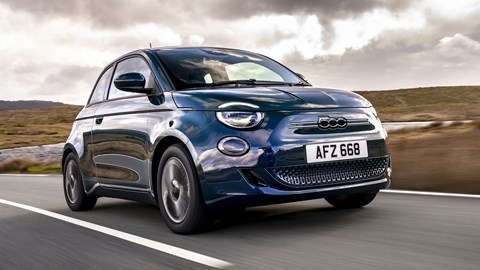
Pros: Easy to handle and park; great piece of design; electric and convertible versions
Cons: Limited interior space; odd driving position; pedestrian performance
The modern iteration of the Fiat 500 made its debut all the way back in 2007 but it’s still a contender in the new city car market; that’s partly due to its charming nature, and partly due to a series of updates that have helped keep it fresh. The latest version packs a mild hybrid three-cylinder petrol powertrain, for example, that’s reputed to average 60.1mpg on the WLTP combined test cycle.
It’s a great car for around-town use, thanks to its small size and nimble nature. Performance isn’t a strong point in the standard models, though, and many rivals offer more interior space. What many don’t offer, however, is a convertible version – and with the Fiat, you can tick the box for the 500C and get a neat drop-top city car. There’s also the excellent All-Electric Fiat 500 or, if you want something hotter, the high-performance Abarth variants.
For a more in-depth look read our Fiat 500 review
Kia Picanto
High-quality hatch is a breeze to live with
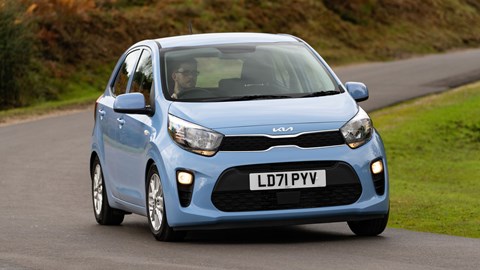
Pros: Seven-year warranty; available with plenty of kit; drives well
Cons: Only one engine option; automatic version is awful; lacks a bit of charm
If you need a city car that can carry four in comparative comfort, Kia’s Picanto is a smartly styled and neatly finished choice. It’s available with a pleasing array of equipment, too; the basic ‘1’ grade comes with features such as Bluetooth connectivity and air conditioning, while the higher-spec ‘3’ model gets climate control, cruise control, navigation, Apple CarPlay and Android Auto support, electric folding mirrors and a reversing camera and rear parking sensors.
One downside, however, is that the Picanto is only offered with a 65bhp 1.0-litre naturally aspirated engine. It’s a perfectly serviceable engine but its output and character means that the Picanto is best suited to pottering around town. But if that’s all you have in mind, you’ll otherwise appreciate the Picanto’s low running costs, long warranty and outright ease of use. An updated version is on the way, too, so keep an eye out for any deals on the outgoing model.
For a more in-depth look read our latest Kia Picanto news story
Toyota Aygo X
Chunky city car has its charms
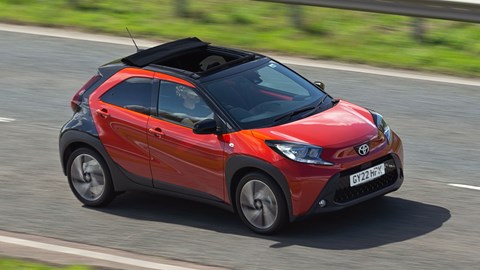
Pros: Decade-long warranty; comfortable and refined; neat canvas roof option
Cons: Expensive compared to rivals; uninspiring performance; limited rear room
An Aygo X is a sensible choice if you value reliability and ease of ownership above all else. Toyota is highly regarded for reliability, after all, and it now offers a ten-year, 100,000-mile warranty, provided you get your car serviced at an official Toyota centre. It’s a far more visually appealing and interesting car than some alternatives, too, while the front cabin space and high equipment levels bolster its desirability further.
The optional neat canvas roof is adds extra charm as well, and many buyers will appreciate the good equipment levels. There’s only one engine option, however, and it really doesn’t serve up anything in the way of performance. Consequently, if you’re intent on venturing out of town and onto faster roads, something with more displacement or a turbocharger would be a better option. The S-CVT option, that said, is a sound candidate for those seeking an automatic car for town or city use.
For a more in-depth look read our Toyota Aygo X review
City cars buyers’ guide
If you’re thinking about buying a city car, first consider how many passengers you might regularly have with you. A lot of city cars can be tight in the back and may only offer seating for four, which might knock some of the options off your list. Similarly, jot down your boot space requirements; boot capacity is measured in litres, and sites such as Parkers.co.uk offer galleries that show the pictures of the boots, so you’ll be able to look at the specification sheets for each car and get some idea how much bigger one is than another.
Most city cars tend to have small and economical three- or four-cylinder petrol engines, some of which are turbocharged. If you’re going to head out of town regularly, or want to tackle motorways in comparative comfort, it’s best to seek out a city car with a more flexible and refined engine. This will help make the car easier and less stressful to drive, and more comfortable over longer distances. There are all-electric options, too, which are excellent if you are happy to deal with range- and charging-related matters.
It’s also important to think about refinement and quality. City cars are often built down to a price and they can be louder and less comfortable inside than superminis. If you’re only using one for short trips around town, this often isn’t a problem. However, if you do need to stretch its legs further afield more often, interior noise and quality can become an issue. Fortunately, some city cars offer decent refinement and higher-quality interiors. We suggest, in any case, that you try out whichever car you’re interested in, just to make sure you’re comfortable with aspects such as its seating position.
Fortunately, these days, many city cars come with lots of equipment, including features such as cruise control and climate control. As is the case with space, though, you need to consider what you want or need, and then use it to help steer your new city car purchase. Don’t forget to use reviews from Carmagazine.co.uk and Parkers.co.uk to help further thin the field, allowing you to quickly identify the best small city car for you.
Best city cars of 2024: FAQs
What makes a good city car?
The best city cars are those that major on the required small-car traits – a compact footprint, affordability, and good practicality for their size – while delivering some big-car vibes, such as good equipment levels and a motorway driving experience that’s surprisingly refined and relaxed. Excellent safety, great reliability, and ease of use are also appreciated when it comes to small city cars.
Are city cars good on the motorway?
A city car might be designed primarily for use in urban areas, and for shorter trips, but that doesn’t mean that they’re incapable of motorway trips. However, some are better than others; if you want a city car to use for motorway driving on a regular basis, it’s best to seek out one of the more refined and powerful options, as it will be more comfortable and relaxing.
Why buy a city car?
Driving in cities can be taxing at the best of times, and many modern cars are large, making encountering width restrictions, parking spaces, or even just oncoming traffic, a situation that causes you to suck air through your teeth. City cars, fortunately, alleviate this stress and hassle by being shorter and narrower, making them easy to handle and manoeuvre around town. Aside from being easy to drive, they’re also cheap to run, straightforward to look after, and often fun to hack around in. New city cars are also available with lots of equipment, so you don’t have to give up much on that front.
What’s the best city car with an automatic gearbox?
Automatic city cars, good ones at least, have always been few and far between. These days, though, the increasing prevalence of all-electric options means there are some super-smooth, super-refined options out there; Fiat’s All-Electric 500, for example, is a single-speed option with simple buttons for park, reverse, neutral, and drive. If you’re looking at more conventional options, then try the CVT-equipped version of the Toyota Aygo X.
What’s the most fuel-efficient city car?
Because these cars are light and use efficient engines, all are capable of delivering impressive economy figures. Out of these here, it’s the Fiat that’s the most frugal, as it’s claimed capable of averaging 60.1mpg on the more realistic WLTP test cycle. Your mileage may vary, however, depending on conditions and driving style. But, generally, most of these cars are claimed to average around 55-60mpg. Of course, you could go for an all-electric option and remove fuel from the equation completely – but then you have to factor in the potential charging costs, both at home and away.